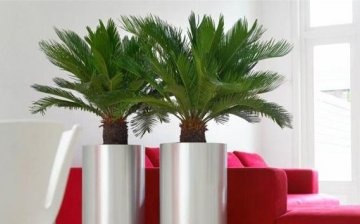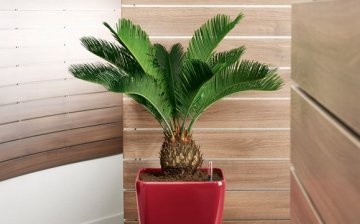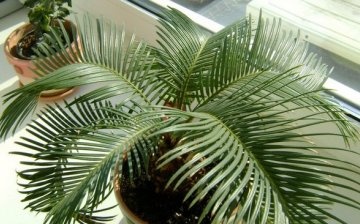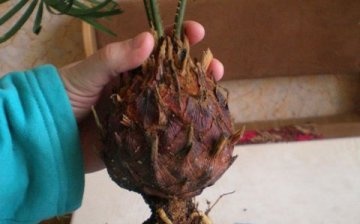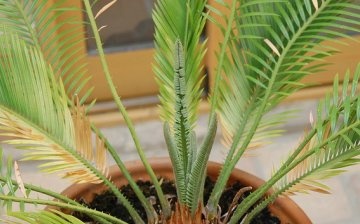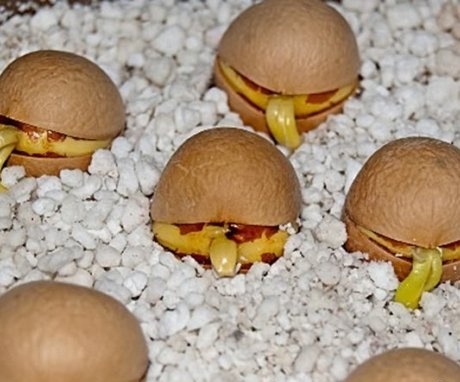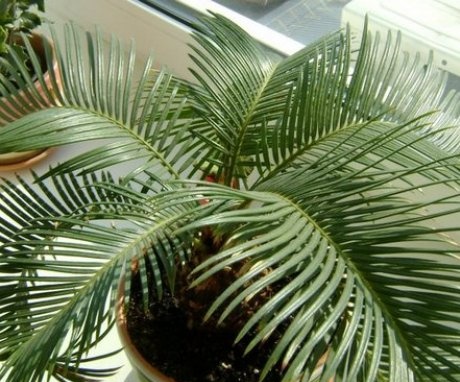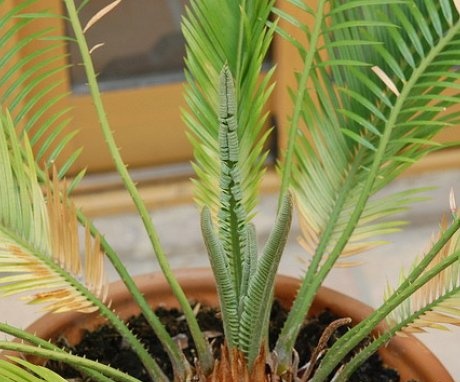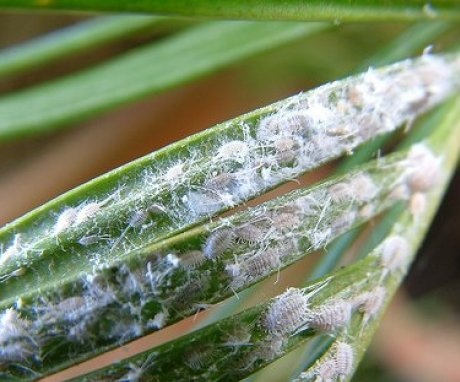Caring for cicada at home: from planting to flowering
Tsikas or sago palm - slow-growing plant with wide attractive exotic-shaped leaves. Large palm trees are used as a decorative element and are installed in the halls of large assignments, offices.
Lovers of indoor floriculture are happy to grow it in their home. It's nice to watch the plant grow and expect a new row of leaves to appear. And the renewal of the sago palm and the appearance of young foliage occurs only once a year. In indoor conditions, a palm tree can only reach 80 cm in height.
Content:
- Description of the plant
- Cycas breeding methods
- Care Tips
- Plant transplant
- Common cicas diseases
- Pest control
Description of the plant
The appearance of the cicassus is reminiscent of a palm tree. The tree trunk of the plant is thickened at the base and can reach 15 m in height. The trunk of a three-meter cicassa in girth approaches 1000 cm. The leaves growing from the top of the trunk are similar to fern leaves. The leaves gradually die off and form a shell - a kind of protection for the plant. Tsikas is a long-liver; it can live for over 100 years. But this applies to natural species, with indoor specimens, the situation is different.
At home, the cicassus reaches only 80 cm in height.
The growth per year is 3 cm. During this time, only one row of leaves appears on the plant. The bright green young foliage is soft to the touch, the entire surface of the leaf plate is covered with hairs. Over time, the foliage becomes harsh, darker with a shiny tint, and the hairs disappear.
The indoor cicada has more similarities with fernrather than with a palm tree, although it is translated from Greek as a palm tree. The plant's slow growth allows flower lovers to grow it as bonsai... During home cultivation, it is almost impossible to wait for the flowering of cicas.
Cycas breeding methods
Propagate cicas seeds only experienced flower growers can do it, but everyone can cope with the rooting of the shoot.
Reproduction by seeds:
- At the top of the trunk, female plants form cones with large orange seeds... But, often, in room conditions, they cannot ripen. To get high-quality seeds, you need a greenhouse temperature, which is impossible to create in an apartment or house.
- If you are lucky enough to get the seeds of the plant, you can try your hand at growing cicada from seeds. Before sowing, they must be soaked in warm water.
- After a day, remove the seeds, spread over wet perlite and dip a little into it.
- For successful seed germination, you will need to maintain the temperature at +25 ° C.
- After 2-3 months, the sprout will first appear, and then the leaf will gradually form.
- Seedling can be transferred into a larger pot of soil for mature plants.
Reproduction by offspring or offshoot:
- If favorable conditions are created for the cicassa, it will develop processes that can be separated for subsequent rooting. You need to cut off the processes with a sharp blade or knife.
- All work should be done carefully so as not to damage the trunk of the sago palm.
- All foliage should be removed from the offspring, the cut site should be treated with fungicidal drugs.
- Bottom stalk dip in a growth stimulator, pour river sand or coarse-grained perlite into a shallow container, plant a stalk and moisten the soil.
- The cut on the mother plant is treated with crushed coal.
The shoot takes root for a very long time. The rooting process can take up to six months, in some cases, up to a year. Until the cutting takes root, the room should be kept at a temperature of + 30 ° C and the perlite should be checked regularly, it should be constantly moist. After the roots have grown, the cutting is transplanted into a larger pot with a growing medium for mature plants.
Care Tips
A cycad will develop well if provided with proper maintenance. Plant growth depends on temperature, adequate lighting, proper watering and feeding.
Lighting:
- The plant is light-loving, but it is not recommended to place a pot of cicas near a window on the south side, or not let the sun's rays fall on the leaves for more than 4 hours a day. It is a four-hour bathing in the sun that the cicassus needs for good development.
- Winter time is characterized by short daylight hours, so it is recommended to make additional lighting for the plant. These can be phytolamps or fluorescent lamps, which should be located at a height of 30-40 cm from the top of the palm tree.
- The plant needs to be illuminated in the dark, during the day it will have enough natural light.
- The optimal duration of daylight hours for the full development of the plant should be 12-14 hours a day.
Temperature range:
- The cycad feels great at temperatures from + 16 ° C to + 24 ° C.
- The temperature regime must not be allowed to drop to below + 13 ° C.
- In winter, the palm tree should take a short rest period, lowering the temperature to + 14 - + 16 ° C.
- The plant needs to be watered only with warm, settled water, it can be boiled cooled down.
- When watering small palms, avoid getting water droplets on the leaves.
- When watering, the water should soak the entire clod of earth. Any excess water will drain into the sump through the drain hole.
- The next watering is required only after the earthen coma has dried.
If the temperature in the room drops below the permissible mark, there is not enough natural light, and there is no way to illuminate the plant, watering should be reduced and carried out as needed, after the earthen lump has completely dried out.
Introduction fertilizers:
- In March, cicas begin to feel a lack of organic matter, therefore, starting in spring, it is necessary to regularly feed the plant with the necessary nutrients. You need to feed the plants once a month.
- From organic matter, horse manure diluted in water can be used for feeding, or mullein.
- It should be noted that the amount of fertilizer applied directly depends on the level of illumination of the plant. If he is provided with full daylight hours, then a full dose of complex mineral fertilizers... The dosage is usually indicated on the package.
An overabundance of nutrients is just as bad for plant development as a lack of it. Therefore, everything should be in moderation. If the plant is in a cool room, and even with poor lighting, the dose of fertilizer applied should be halved.
Plant transplant
A young plant needs transfer Once every 3 years. More mature plants do not require such frequent replanting, so do not disturb them. An adult plant needs a transplant only if the pot in which it grows has become small for it.
Much attention should be paid to the container for planting. When choosing a pot, you should take into account the diameter of the trunk and build on the resulting figure when buying.For example, if the diameter of the trunk is 5 cm, then the capacity is selected as follows: the diameter of the trunk must be multiplied by 3 and the diameter of the pot is obtained. To find out the height, you need to multiply the resulting width by 2. In this case, the width of the container turned out to be 15 cm with a height of 30 cm.
For planting a plant, it is preferable to choose a slightly acidic or neutral soil. The soil should be light, air permeable.
To find out if the soil is properly prepared for landing cicada, place it in a flower pot and sprinkle with water. If water appears in the pan in an instant, it means that the soil is compiled according to all the rules. If the soil is heavy, water will seep through the drainage holes and only appear in the sump after a few minutes. Such a soil mixture is not suitable for planting cicas.
Composition of soil for growing exotic palm trees:
- Pumice - 1 part
- Coarse pine bark - 1 part
- Bone meal - 0.1 parts
- Dolomite shaben - part 1
- Coarse peat - part 1
- Large perlite - 1 part.
All components must be mixed and disinfected. When compiling a soil mixture, it is necessary to avoid components that will reduce the air permeability of the soil and lead to its waterlogging. These components include clay soil, fine river sand.
You can improve the composition of the soil using pumice, large perlite, pebbles, wood chips, adding them to the prepared soil for planting.
Before transplanting, a third of the foliage is removed from the plant, while removing all the old ones. You need to transfer plants with a lump of earth. First, it does not traumatize the root system. And secondly, the cicada does not like to part with the usual substrate.
Common cicas diseases
An improperly formulated mixture leads to different diseases, the plants are weakened and exposed to the invasion of harmful insects.
Caudex (lower trunk) rot and root decay. The disease can be recognized by brownish or dark spots that appear on the trunk. When examining the root system, you may notice the absence of secondary roots, or they become dark and soft.
Control methods:
- When inspecting the plant, all the damaged trunk tissue and the rotted part of the roots are cut out.
- The plant, trimmed to healthy tissue, is dipped for 0.5 hour in a disinfecting fungicidal solution prepared in accordance with the instructions.
- The root system is dipped in a root-forming solution and kept in it for as long as indicated by the manufacturer in the instructions.
- Wax is fused onto the cut, and the plant is planted in a pot.
It will take at least six months to recuperate the cicassa. If during this time no improvement is observed, but, on the contrary, the spots continue to appear, then it is necessary to re-conduct processing.
Top part of the trunk rot - if the top rots, it means that the plant can no longer be saved.
The foliage becomes brown, curls and falls off. If you touch the top with the pad of your finger and press lightly, it will easily fall inward. Control measures are similar. If it is clear that the treatment does not bring any results, all efforts have been wasted, it is necessary to separate the offspring and root them. This is the only way to preserve your favorite cicada variety.
Pest control
Cicas are rarely damaged pests, but this does not mean that it should not be examined for the appearance of insects. Regular inspection will help to identify pests in time and carry out timely control.
- Shield. The most harmful insect that does not lend itself to insecticides, since its body is protected by a wax coating. It is still difficult to fight with scale insects because some individuals hide in the ground. Therefore, you should tune in to the fact that the process of dealing with the shield will be long. Of the chemicals, we can recommend "Carbaril", "Pirikroxyfen", "Acephate", "Pyrethrin".Plants are treated 3 times with an interval of 5 days. But before processing with pesticides, it is recommended to collect adult scale insects by hand.
- Aphid. After attacking the plant, the aphid settles on the leaves and sucks the juice out of them. The plant weakens, the leaves curl. To combat aphids, phosphorus-containing preparations are used, the treatment with which is carried out 3 times with an interval between sprays of 3 days.
- Mealybugs. Small pests cause a lot of trouble and can lead to the death of the plant. First, they are collected mechanically - by hand, and then treated with a preparation containing cypermethrin. Mealybugs are also present in the soil, therefore, not only the upper part, but also the soil should be processed.
Growing cicas at home is an interesting and exciting experience. It's nice to watch its development. But when growing, it should be remembered that an exotic plant, including the trunk and foliage, contains neurotoxins - poisonous substances. That is, the plant is dangerous to human health. But if you follow the precautions, you can admire the beauty of the spreading leaves all year round.
More information can be found in the video.



